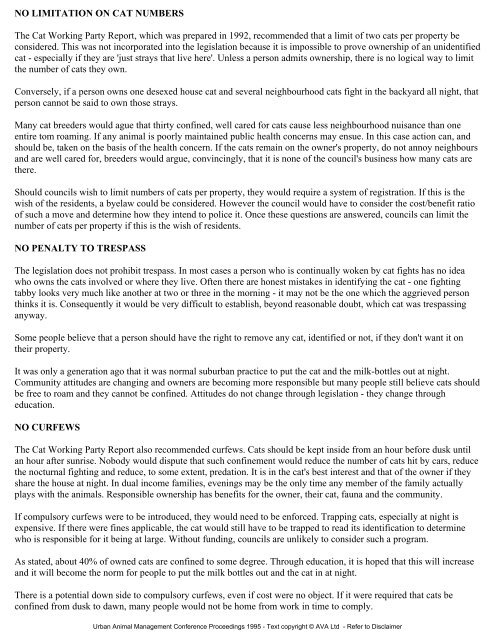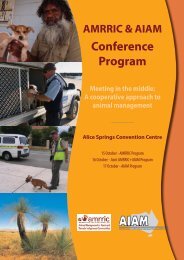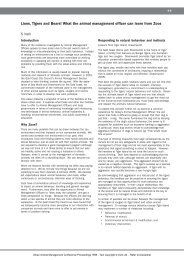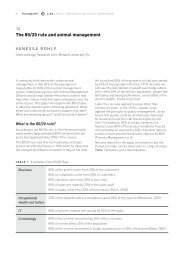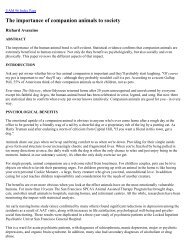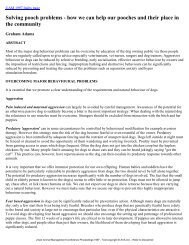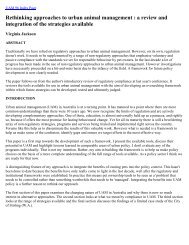Cat legislation in South Australia - Australian Institute of Animal ...
Cat legislation in South Australia - Australian Institute of Animal ...
Cat legislation in South Australia - Australian Institute of Animal ...
You also want an ePaper? Increase the reach of your titles
YUMPU automatically turns print PDFs into web optimized ePapers that Google loves.
NO LIMITATION ON CAT NUMBERS<br />
The <strong>Cat</strong> Work<strong>in</strong>g Party Report, which was prepared <strong>in</strong> 1992, recommended that a limit <strong>of</strong> two cats per property be<br />
considered. This was not <strong>in</strong>corporated <strong>in</strong>to the <strong>legislation</strong> because it is impossible to prove ownership <strong>of</strong> an unidentified<br />
cat - especially if they are 'just strays that live here'. Unless a person admits ownership, there is no logical way to limit<br />
the number <strong>of</strong> cats they own.<br />
Conversely, if a person owns one desexed house cat and several neighbourhood cats fight <strong>in</strong> the backyard all night, that<br />
person cannot be said to own those strays.<br />
Many cat breeders would ague that thirty conf<strong>in</strong>ed, well cared for cats cause less neighbourhood nuisance than one<br />
entire tom roam<strong>in</strong>g. If any animal is poorly ma<strong>in</strong>ta<strong>in</strong>ed public health concerns may ensue. In this case action can, and<br />
should be, taken on the basis <strong>of</strong> the health concern. If the cats rema<strong>in</strong> on the owner's property, do not annoy neighbours<br />
and are well cared for, breeders would argue, conv<strong>in</strong>c<strong>in</strong>gly, that it is none <strong>of</strong> the council's bus<strong>in</strong>ess how many cats are<br />
there.<br />
Should councils wish to limit numbers <strong>of</strong> cats per property, they would require a system <strong>of</strong> registration. If this is the<br />
wish <strong>of</strong> the residents, a byelaw could be considered. However the council would have to consider the cost/benefit ratio<br />
<strong>of</strong> such a move and determ<strong>in</strong>e how they <strong>in</strong>tend to police it. Once these questions are answered, councils can limit the<br />
number <strong>of</strong> cats per property if this is the wish <strong>of</strong> residents.<br />
NO PENALTY TO TRESPASS<br />
The <strong>legislation</strong> does not prohibit trespass. In most cases a person who is cont<strong>in</strong>ually woken by cat fights has no idea<br />
who owns the cats <strong>in</strong>volved or where they live. Often there are honest mistakes <strong>in</strong> identify<strong>in</strong>g the cat - one fight<strong>in</strong>g<br />
tabby looks very much like another at two or three <strong>in</strong> the morn<strong>in</strong>g - it may not be the one which the aggrieved person<br />
th<strong>in</strong>ks it is. Consequently it would be very difficult to establish, beyond reasonable doubt, which cat was trespass<strong>in</strong>g<br />
anyway.<br />
Some people believe that a person should have the right to remove any cat, identified or not, if they don't want it on<br />
their property.<br />
It was only a generation ago that it was normal suburban practice to put the cat and the milk-bottles out at night.<br />
Community attitudes are chang<strong>in</strong>g and owners are becom<strong>in</strong>g more responsible but many people still believe cats should<br />
be free to roam and they cannot be conf<strong>in</strong>ed. Attitudes do not change through <strong>legislation</strong> - they change through<br />
education.<br />
NO CURFEWS<br />
The <strong>Cat</strong> Work<strong>in</strong>g Party Report also recommended curfews. <strong>Cat</strong>s should be kept <strong>in</strong>side from an hour before dusk until<br />
an hour after sunrise. Nobody would dispute that such conf<strong>in</strong>ement would reduce the number <strong>of</strong> cats hit by cars, reduce<br />
the nocturnal fight<strong>in</strong>g and reduce, to some extent, predation. It is <strong>in</strong> the cat's best <strong>in</strong>terest and that <strong>of</strong> the owner if they<br />
share the house at night. In dual <strong>in</strong>come families, even<strong>in</strong>gs may be the only time any member <strong>of</strong> the family actually<br />
plays with the animals. Responsible ownership has benefits for the owner, their cat, fauna and the community.<br />
If compulsory curfews were to be <strong>in</strong>troduced, they would need to be enforced. Trapp<strong>in</strong>g cats, especially at night is<br />
expensive. If there were f<strong>in</strong>es applicable, the cat would still have to be trapped to read its identification to determ<strong>in</strong>e<br />
who is responsible for it be<strong>in</strong>g at large. Without fund<strong>in</strong>g, councils are unlikely to consider such a program.<br />
As stated, about 40% <strong>of</strong> owned cats are conf<strong>in</strong>ed to some degree. Through education, it is hoped that this will <strong>in</strong>crease<br />
and it will become the norm for people to put the milk bottles out and the cat <strong>in</strong> at night.<br />
There is a potential down side to compulsory curfews, even if cost were no object. If it were required that cats be<br />
conf<strong>in</strong>ed from dusk to dawn, many people would not be home from work <strong>in</strong> time to comply.<br />
Urban <strong>Animal</strong> Management Conference Proceed<strong>in</strong>gs 1995 - Text copyright © AVA Ltd - Refer to Disclaimer


